sensor LINCOLN NAUTILUS 2021 Owners Manual
[x] Cancel search | Manufacturer: LINCOLN, Model Year: 2021, Model line: NAUTILUS, Model: LINCOLN NAUTILUS 2021Pages: 579, PDF Size: 6.9 MB
Page 5 of 579
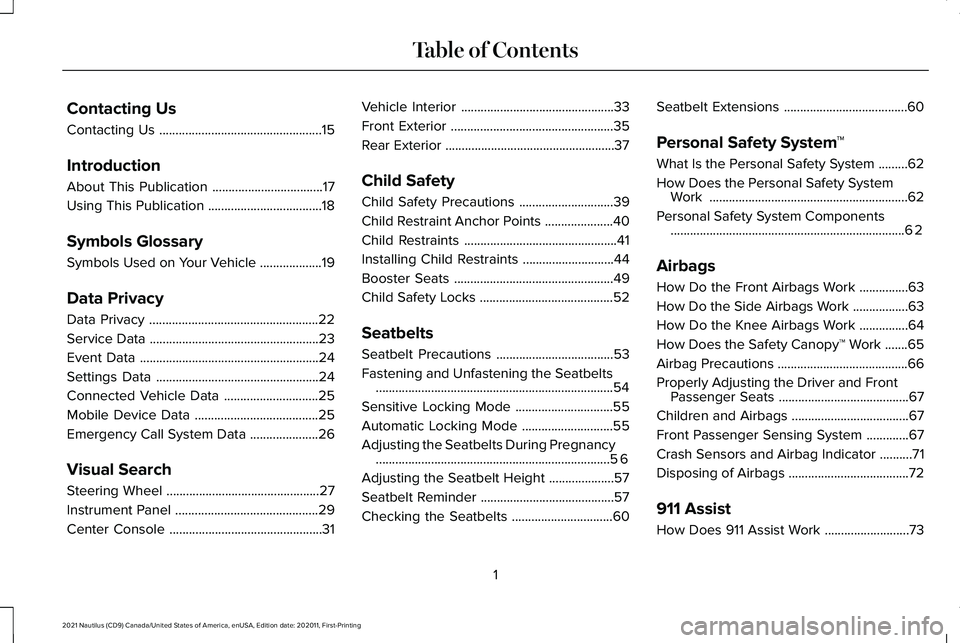
Contacting Us
Contacting Us
..................................................15
Introduction
About This Publication ..................................
17
Using This Publication ...................................
18
Symbols Glossary
Symbols Used on Your Vehicle ...................
19
Data Privacy
Data Privacy ....................................................
22
Service Data ....................................................
23
Event Data .......................................................
24
Settings Data ..................................................
24
Connected Vehicle Data .............................
25
Mobile Device Data ......................................
25
Emergency Call System Data .....................
26
Visual Search
Steering Wheel ...............................................
27
Instrument Panel ............................................
29
Center Console ...............................................
31Vehicle Interior
...............................................
33
Front Exterior ..................................................
35
Rear Exterior ....................................................
37
Child Safety
Child Safety Precautions .............................
39
Child Restraint Anchor Points .....................
40
Child Restraints ...............................................
41
Installing Child Restraints ............................
44
Booster Seats .................................................
49
Child Safety Locks .........................................
52
Seatbelts
Seatbelt Precautions ....................................
53
Fastening and Unfastening the Seatbelts ........................................................................\
.
54
Sensitive Locking Mode ..............................
55
Automatic Locking Mode ............................
55
Adjusting the Seatbelts During Pregnancy ........................................................................\
56
Adjusting the Seatbelt Height ....................
57
Seatbelt Reminder .........................................
57
Checking the Seatbelts ...............................
60Seatbelt Extensions
......................................
60
Personal Safety System ™
What Is the Personal Safety System .........
62
How Does the Personal Safety System Work .............................................................
62
Personal Safety System Components ........................................................................\
62
Airbags
How Do the Front Airbags Work ...............
63
How Do the Side Airbags Work .................
63
How Do the Knee Airbags Work ...............
64
How Does the Safety Canopy™ Work .......
65
Airbag Precautions ........................................
66
Properly Adjusting the Driver and Front Passenger Seats ........................................
67
Children and Airbags ....................................
67
Front Passenger Sensing System .............
67
Crash Sensors and Airbag Indicator ..........
71
Disposing of Airbags .....................................
72
911 Assist
How Does 911 Assist Work ..........................
73
1
2021 Nautilus (CD9) Canada/United States of America, enUSA, Edition date: 202011, First-Printing Table of Contents
Page 13 of 579
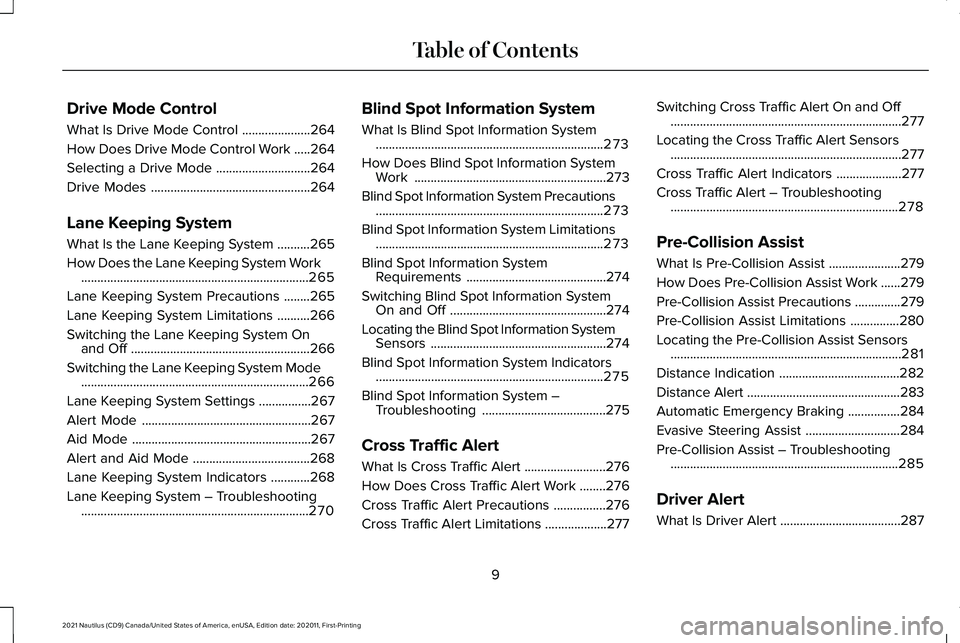
Drive Mode Control
What Is Drive Mode Control
.....................264
How Does Drive Mode Control Work .....
264
Selecting a Drive Mode .............................
264
Drive Modes .................................................
264
Lane Keeping System
What Is the Lane Keeping System ..........
265
How Does the Lane Keeping System Work ......................................................................
265
Lane Keeping System Precautions ........
265
Lane Keeping System Limitations ..........
266
Switching the Lane Keeping System On and Off .......................................................
266
Switching the Lane Keeping System Mode ......................................................................
266
Lane Keeping System Settings ................
267
Alert Mode ....................................................
267
Aid Mode .......................................................
267
Alert and Aid Mode ....................................
268
Lane Keeping System Indicators ............
268
Lane Keeping System – Troubleshooting ......................................................................
270 Blind Spot Information System
What Is Blind Spot Information System
......................................................................
273
How Does Blind Spot Information System Work ...........................................................
273
Blind Spot Information System Precautions ......................................................................
273
Blind Spot Information System Limitations ......................................................................
273
Blind Spot Information System Requirements ...........................................
274
Switching Blind Spot Information System On and Off ................................................
274
Locating the Blind Spot Information System Sensors ......................................................
274
Blind Spot Information System Indicators ......................................................................
275
Blind Spot Information System – Troubleshooting ......................................
275
Cross Traffic Alert
What Is Cross Traffic Alert .........................
276
How Does Cross Traffic Alert Work ........
276
Cross Traffic Alert Precautions ................
276
Cross Traffic Alert Limitations ...................
277Switching Cross Traffic Alert On and Off
.......................................................................
277
Locating the Cross Traffic Alert Sensors .......................................................................
277
Cross Traffic Alert Indicators ....................
277
Cross Traffic Alert – Troubleshooting ......................................................................
278
Pre-Collision Assist
What Is Pre-Collision Assist ......................
279
How Does Pre-Collision Assist Work ......
279
Pre-Collision Assist Precautions ..............
279
Pre-Collision Assist Limitations ...............
280
Locating the Pre-Collision Assist Sensors .......................................................................
281
Distance Indication .....................................
282
Distance Alert ...............................................
283
Automatic Emergency Braking ................
284
Evasive Steering Assist .............................
284
Pre-Collision Assist – Troubleshooting ......................................................................
285
Driver Alert
What Is Driver Alert .....................................
287
9
2021 Nautilus (CD9) Canada/United States of America, enUSA, Edition date: 202011, First-Printing Table of Contents
Page 40 of 579
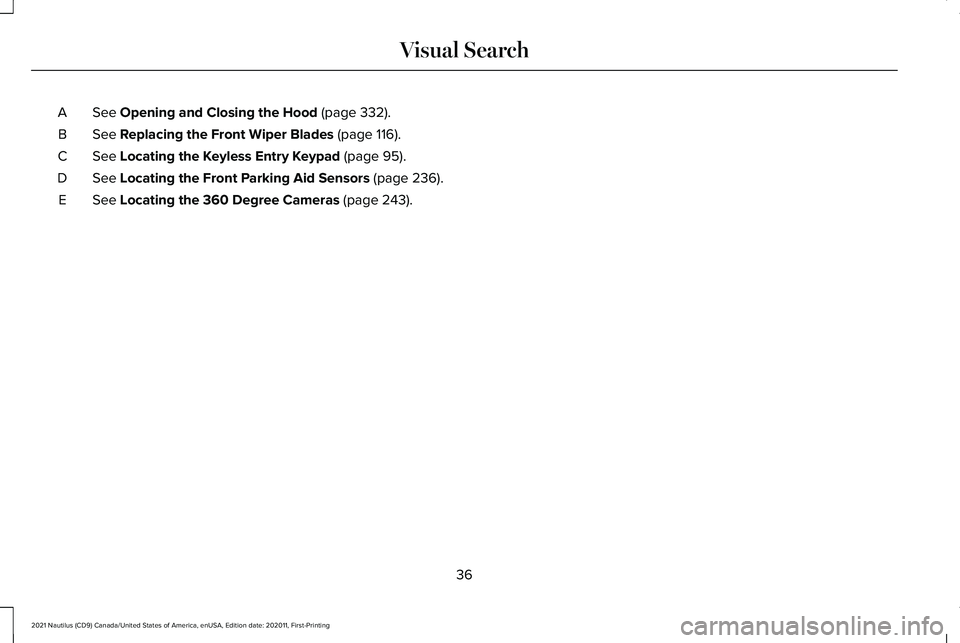
See Opening and Closing the Hood (page 332).
A
See
Replacing the Front Wiper Blades (page 116).
B
See
Locating the Keyless Entry Keypad (page 95).
C
See
Locating the Front Parking Aid Sensors (page 236).
D
See
Locating the 360 Degree Cameras (page 243).
E
36
2021 Nautilus (CD9) Canada/United States of America, enUSA, Edition date: 202011, First-Printing Visual Search
Page 42 of 579
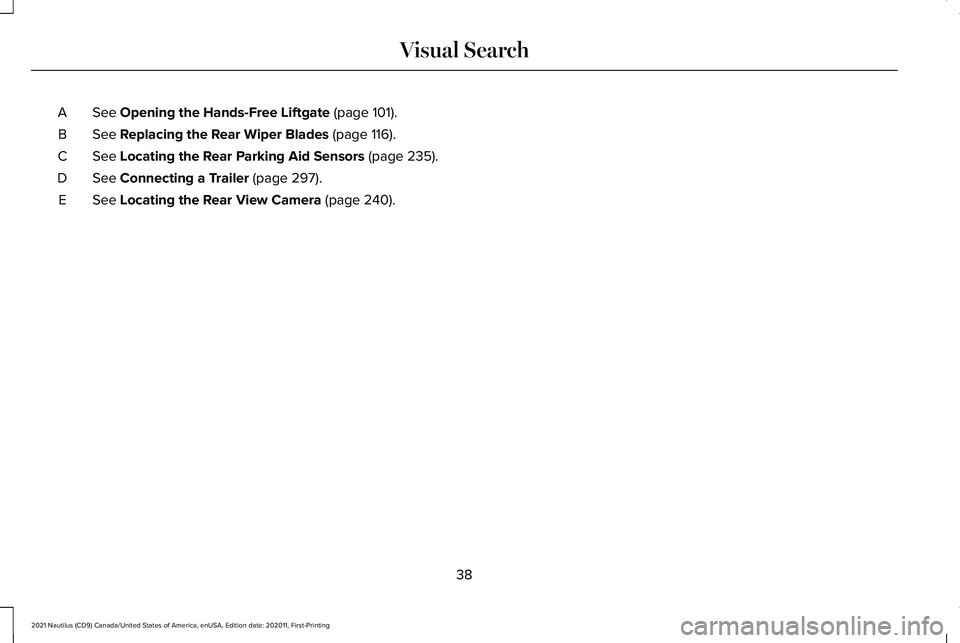
See Opening the Hands-Free Liftgate (page 101).
A
See
Replacing the Rear Wiper Blades (page 116).
B
See
Locating the Rear Parking Aid Sensors (page 235).
C
See
Connecting a Trailer (page 297).
D
See
Locating the Rear View Camera (page 240).
E
38
2021 Nautilus (CD9) Canada/United States of America, enUSA, Edition date: 202011, First-Printing Visual Search
Page 58 of 579
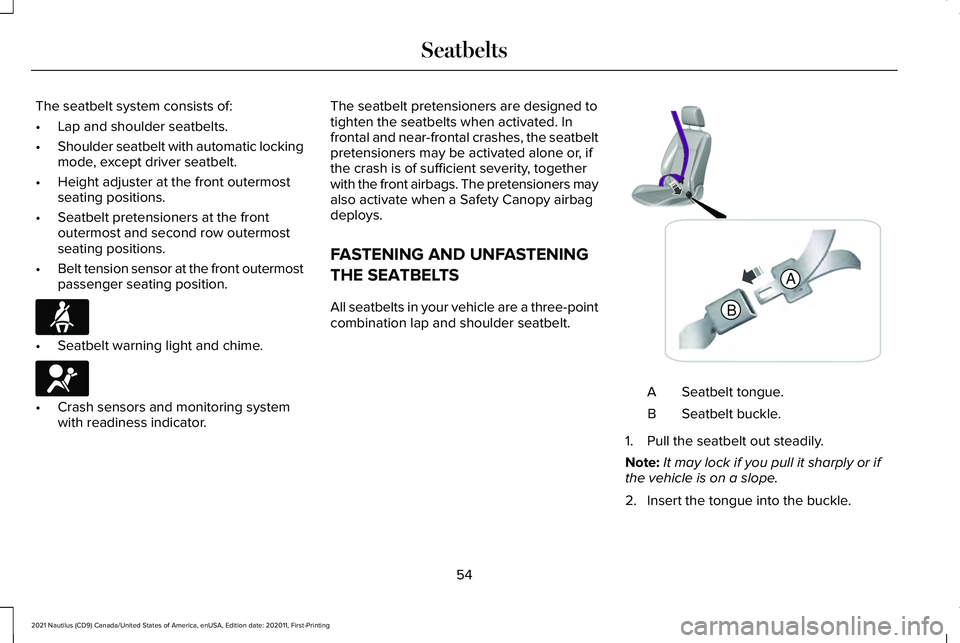
The seatbelt system consists of:
•
Lap and shoulder seatbelts.
• Shoulder seatbelt with automatic locking
mode, except driver seatbelt.
• Height adjuster at the front outermost
seating positions.
• Seatbelt pretensioners at the front
outermost and second row outermost
seating positions.
• Belt tension sensor at the front outermost
passenger seating position. •
Seatbelt warning light and chime. •
Crash sensors and monitoring system
with readiness indicator. The seatbelt pretensioners are designed to
tighten the seatbelts when activated. In
frontal and near-frontal crashes, the seatbelt
pretensioners may be activated alone or, if
the crash is of sufficient severity, together
with the front airbags. The pretensioners may
also activate when a Safety Canopy airbag
deploys.
FASTENING AND UNFASTENING
THE SEATBELTS
All seatbelts in your vehicle are a three-point
combination lap and shoulder seatbelt.
Seatbelt tongue.
A
Seatbelt buckle.
B
1. Pull the seatbelt out steadily.
Note: It may lock if you pull it sharply or if
the vehicle is on a slope.
2. Insert the tongue into the buckle.
54
2021 Nautilus (CD9) Canada/United States of America, enUSA, Edition date: 202011, First-Printing SeatbeltsE71880 E67017 B
A E338014
Page 66 of 579
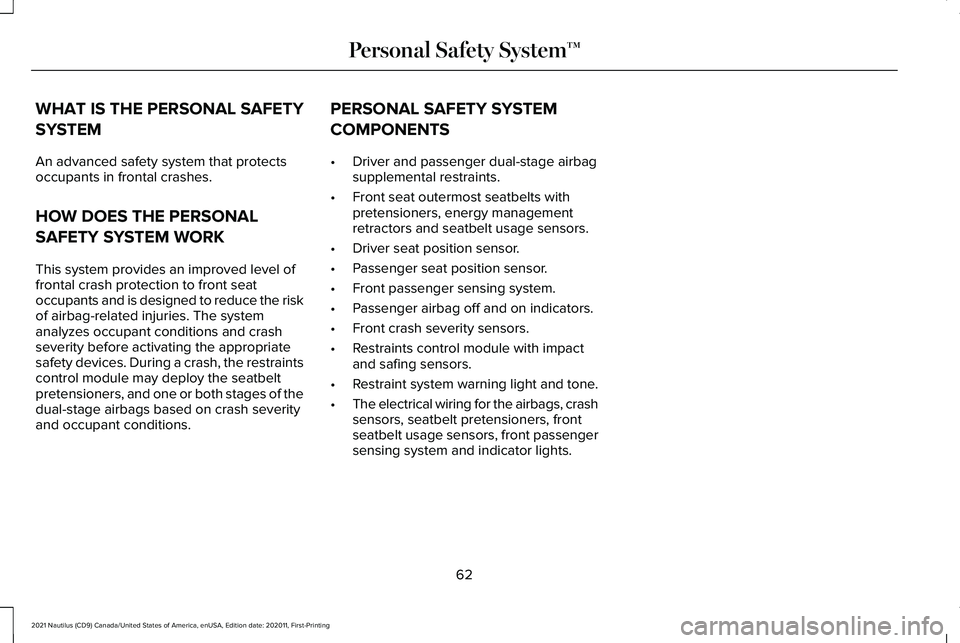
WHAT IS THE PERSONAL SAFETY
SYSTEM
An advanced safety system that protects
occupants in frontal crashes.
HOW DOES THE PERSONAL
SAFETY SYSTEM WORK
This system provides an improved level of
frontal crash protection to front seat
occupants and is designed to reduce the risk
of airbag-related injuries. The system
analyzes occupant conditions and crash
severity before activating the appropriate
safety devices. During a crash, the restraints
control module may deploy the seatbelt
pretensioners, and one or both stages of the
dual-stage airbags based on crash severity
and occupant conditions.
PERSONAL SAFETY SYSTEM
COMPONENTS
•
Driver and passenger dual-stage airbag
supplemental restraints.
• Front seat outermost seatbelts with
pretensioners, energy management
retractors and seatbelt usage sensors.
• Driver seat position sensor.
• Passenger seat position sensor.
• Front passenger sensing system.
• Passenger airbag off and on indicators.
• Front crash severity sensors.
• Restraints control module with impact
and safing sensors.
• Restraint system warning light and tone.
• The electrical wiring for the airbags, crash
sensors, seatbelt pretensioners, front
seatbelt usage sensors, front passenger
sensing system and indicator lights.
62
2021 Nautilus (CD9) Canada/United States of America, enUSA, Edition date: 202011, First-Printing Personal Safety System
™
Page 67 of 579
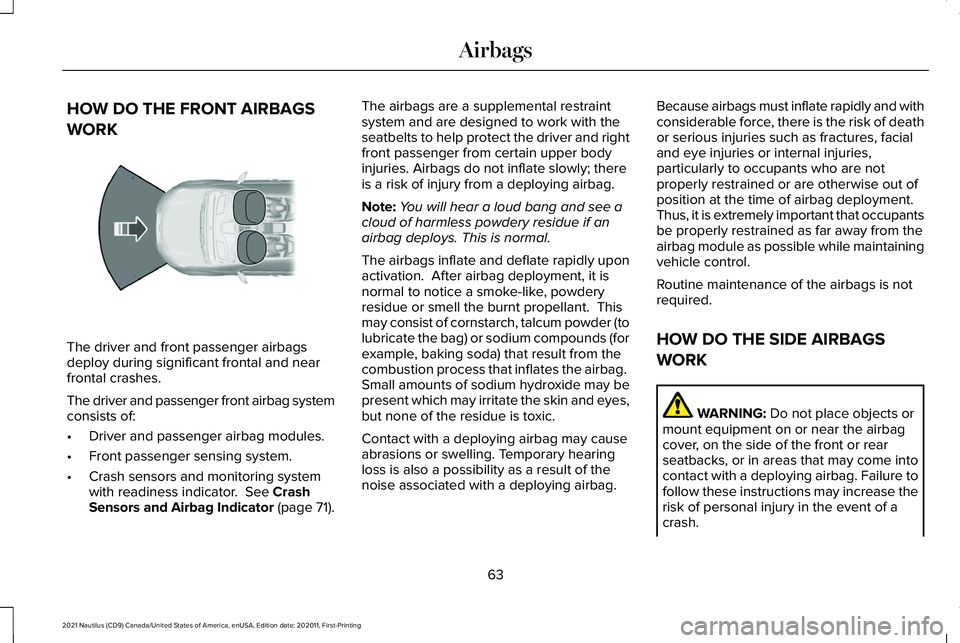
HOW DO THE FRONT AIRBAGS
WORK
The driver and front passenger airbags
deploy during significant frontal and near
frontal crashes.
The driver and passenger front airbag system
consists of:
•
Driver and passenger airbag modules.
• Front passenger sensing system.
• Crash sensors and monitoring system
with readiness indicator. See Crash
Sensors and Airbag Indicator (page 71). The airbags are a supplemental restraint
system and are designed to work with the
seatbelts to help protect the driver and right
front passenger from certain upper body
injuries. Airbags do not inflate slowly; there
is a risk of injury from a deploying airbag.
Note:
You will hear a loud bang and see a
cloud of harmless powdery residue if an
airbag deploys. This is normal.
The airbags inflate and deflate rapidly upon
activation. After airbag deployment, it is
normal to notice a smoke-like, powdery
residue or smell the burnt propellant. This
may consist of cornstarch, talcum powder (to
lubricate the bag) or sodium compounds (for
example, baking soda) that result from the
combustion process that inflates the airbag.
Small amounts of sodium hydroxide may be
present which may irritate the skin and eyes,
but none of the residue is toxic.
Contact with a deploying airbag may cause
abrasions or swelling. Temporary hearing
loss is also a possibility as a result of the
noise associated with a deploying airbag. Because airbags must inflate rapidly and with
considerable force, there is the risk of death
or serious injuries such as fractures, facial
and eye injuries or internal injuries,
particularly to occupants who are not
properly restrained or are otherwise out of
position at the time of airbag deployment.
Thus, it is extremely important that occupants
be properly restrained as far away from the
airbag module as possible while maintaining
vehicle control.
Routine maintenance of the airbags is not
required.
HOW DO THE SIDE AIRBAGS
WORK
WARNING:
Do not place objects or
mount equipment on or near the airbag
cover, on the side of the front or rear
seatbacks, or in areas that may come into
contact with a deploying airbag. Failure to
follow these instructions may increase the
risk of personal injury in the event of a
crash.
63
2021 Nautilus (CD9) Canada/United States of America, enUSA, Edition date: 202011, First-Printing Airbags E151127
Page 68 of 579
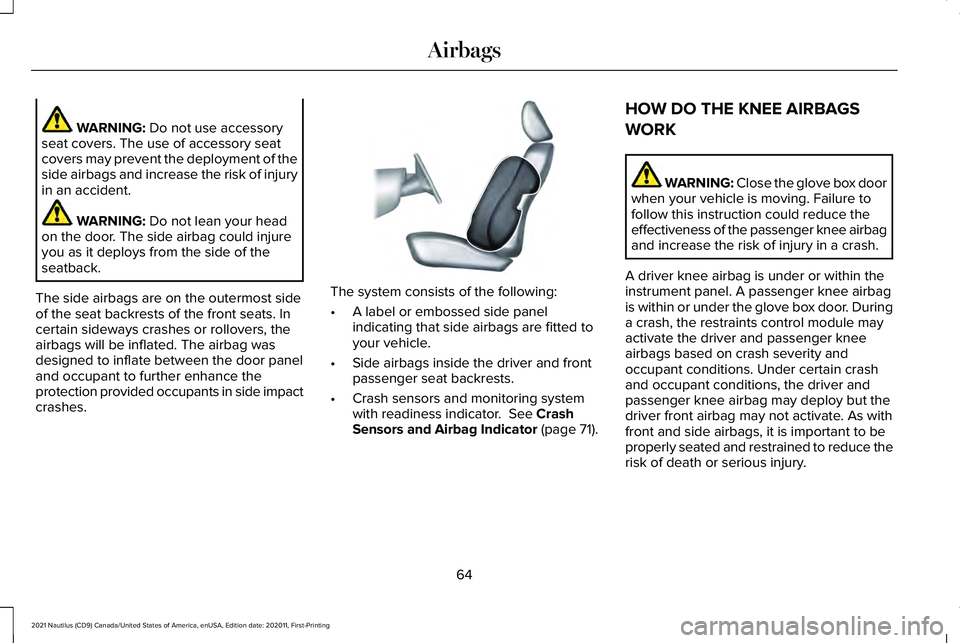
WARNING: Do not use accessory
seat covers. The use of accessory seat
covers may prevent the deployment of the
side airbags and increase the risk of injury
in an accident. WARNING:
Do not lean your head
on the door. The side airbag could injure
you as it deploys from the side of the
seatback.
The side airbags are on the outermost side
of the seat backrests of the front seats. In
certain sideways crashes or rollovers, the
airbags will be inflated. The airbag was
designed to inflate between the door panel
and occupant to further enhance the
protection provided occupants in side impact
crashes. The system consists of the following:
•
A label or embossed side panel
indicating that side airbags are fitted to
your vehicle.
• Side airbags inside the driver and front
passenger seat backrests.
• Crash sensors and monitoring system
with readiness indicator.
See Crash
Sensors and Airbag Indicator (page 71). HOW DO THE KNEE AIRBAGS
WORK WARNING: Close the glove box door
when your vehicle is moving. Failure to
follow this instruction could reduce the
effectiveness of the passenger knee airbag
and increase the risk of injury in a crash.
A driver knee airbag is under or within the
instrument panel. A passenger knee airbag
is within or under the glove box door. During
a crash, the restraints control module may
activate the driver and passenger knee
airbags based on crash severity and
occupant conditions. Under certain crash
and occupant conditions, the driver and
passenger knee airbag may deploy but the
driver front airbag may not activate. As with
front and side airbags, it is important to be
properly seated and restrained to reduce the
risk of death or serious injury.
64
2021 Nautilus (CD9) Canada/United States of America, enUSA, Edition date: 202011, First-Printing AirbagsE152533
Page 69 of 579
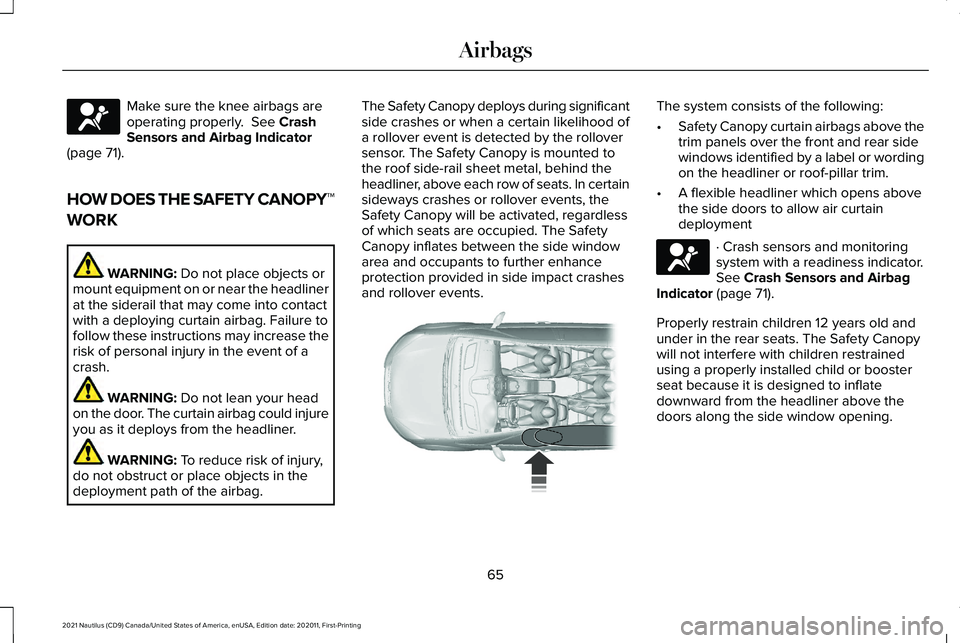
Make sure the knee airbags are
operating properly. See Crash
Sensors and Airbag Indicator
(page
71).
HOW DOES THE SAFETY CANOPY™
WORK WARNING:
Do not place objects or
mount equipment on or near the headliner
at the siderail that may come into contact
with a deploying curtain airbag. Failure to
follow these instructions may increase the
risk of personal injury in the event of a
crash. WARNING:
Do not lean your head
on the door. The curtain airbag could injure
you as it deploys from the headliner. WARNING:
To reduce risk of injury,
do not obstruct or place objects in the
deployment path of the airbag. The Safety Canopy deploys during significant
side crashes or when a certain likelihood of
a rollover event is detected by the rollover
sensor. The Safety Canopy is mounted to
the roof side-rail sheet metal, behind the
headliner, above each row of seats. In certain
sideways crashes or rollover events, the
Safety Canopy will be activated, regardless
of which seats are occupied. The Safety
Canopy inflates between the side window
area and occupants to further enhance
protection provided in side impact crashes
and rollover events. The system consists of the following:
•
Safety Canopy curtain airbags above the
trim panels over the front and rear side
windows identified by a label or wording
on the headliner or roof-pillar trim.
• A flexible headliner which opens above
the side doors to allow air curtain
deployment · Crash sensors and monitoring
system with a readiness indicator.
See
Crash Sensors and Airbag
Indicator (page 71).
Properly restrain children 12 years old and
under in the rear seats. The Safety Canopy
will not interfere with children restrained
using a properly installed child or booster
seat because it is designed to inflate
downward from the headliner above the
doors along the side window opening.
65
2021 Nautilus (CD9) Canada/United States of America, enUSA, Edition date: 202011, First-Printing AirbagsE67017 E75004 E67017
Page 72 of 579
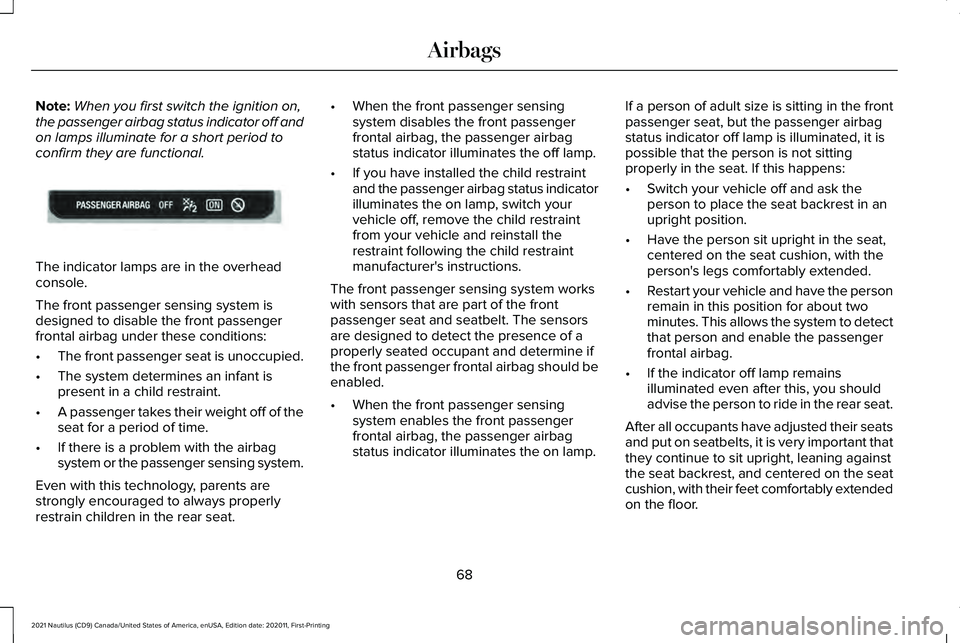
Note:
When you first switch the ignition on,
the passenger airbag status indicator off and
on lamps illuminate for a short period to
confirm they are functional. The indicator lamps are in the overhead
console.
The front passenger sensing system is
designed to disable the front passenger
frontal airbag under these conditions:
•
The front passenger seat is unoccupied.
• The system determines an infant is
present in a child restraint.
• A passenger takes their weight off of the
seat for a period of time.
• If there is a problem with the airbag
system or the passenger sensing system.
Even with this technology, parents are
strongly encouraged to always properly
restrain children in the rear seat. •
When the front passenger sensing
system disables the front passenger
frontal airbag, the passenger airbag
status indicator illuminates the off lamp.
• If you have installed the child restraint
and the passenger airbag status indicator
illuminates the on lamp, switch your
vehicle off, remove the child restraint
from your vehicle and reinstall the
restraint following the child restraint
manufacturer's instructions.
The front passenger sensing system works
with sensors that are part of the front
passenger seat and seatbelt. The sensors
are designed to detect the presence of a
properly seated occupant and determine if
the front passenger frontal airbag should be
enabled.
• When the front passenger sensing
system enables the front passenger
frontal airbag, the passenger airbag
status indicator illuminates the on lamp. If a person of adult size is sitting in the front
passenger seat, but the passenger airbag
status indicator off lamp is illuminated, it is
possible that the person is not sitting
properly in the seat. If this happens:
•
Switch your vehicle off and ask the
person to place the seat backrest in an
upright position.
• Have the person sit upright in the seat,
centered on the seat cushion, with the
person's legs comfortably extended.
• Restart your vehicle and have the person
remain in this position for about two
minutes. This allows the system to detect
that person and enable the passenger
frontal airbag.
• If the indicator off lamp remains
illuminated even after this, you should
advise the person to ride in the rear seat.
After all occupants have adjusted their seats
and put on seatbelts, it is very important that
they continue to sit upright, leaning against
the seat backrest, and centered on the seat
cushion, with their feet comfortably extended
on the floor.
68
2021 Nautilus (CD9) Canada/United States of America, enUSA, Edition date: 202011, First-Printing AirbagsE181984